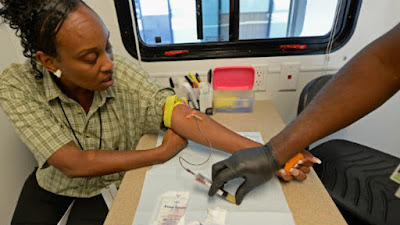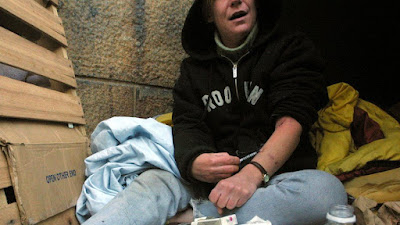By: Marcus J. Hopkins, Founder & Executive Director, Appalachian Learning Initiative
The Health Resources and Services Administration (HRSA) has released the first Ryan White HIV/AIDS Program COVID-19 Data Report covering activities conducted from January 20, 2020, through September 30, 2021 (HRSA, 2022b). These activities were funded by the Coronavirus Aid, Relief, and Economic Security Act (CARES Act) of 2020, are the data contained therein were gathered using the COVID-19 Data Report (CDR) system developed by HRSA to receive monthly, aggregate-level reporting from providers were accepted and utilized funds provided by the CARES Act.
Before we get started on the data analyses contained within that report, however, it is vital to put this report into what I believe to be the proper context: that of the patient.
How the COVID-19 Pandemic Impacted People Living with HIV
The very first point that must be made is that, despite the title of this blog, the novel Coronavirus—SARS-COV-2 (COVID-19)—is not behind us.
Since March 2020, roughly 1 million Americans have lost their lives to COVID-19 (Stein, 2022), including one of my mentors in the fight against HIV/AIDS, former Long Beach AIDS Foundation Director, Garry Bowie, who died in April 2020. His was the first, but not the last, loss I experienced due to COVID and truly set the stage for the years to come. Garry is survived by his husband, Jeff Wacha, who continues to work in the non-profit sector.
For those of us living with HIV and those of us old enough to remember the early years of the HIV/AIDS epidemic, many memories were stirred in those first days. For me, it was the nervous sense of dread, just waiting to receive the next piece of news on Facebook that another friend had died. Every cough carried with it the threat of being intubated or having to sit alone in your car in the parking lot waiting to receive what seemed like the inevitable “bad news.”
But this time, it was somehow worse because we couldn’t even get together for a viewing, a wake, a funeral, a celebration of life…all of these opportunities to grieve with, seek comfort from, or provide solace to our friends and loved ones were all but eliminated for fear that, by gathering, we would be the next one on a rapidly growing epitaph. For those Americans who were concerned about the virus, we watched in horror as morgues reached their capacities, overspilled into hallways, and then flooded into refrigerated storage units.
In addition to our worries about COVID-19, those of us living with HIV and countless others living with chronic conditions that require somewhat regular healthcare services provision were met with the stark reality that those services were going to have to be put on hold. Medical appointments were canceled with no replacement dates offered, treatments and surgeries were indefinitely postponed, and clinics, hospitals, and other providers all but locked down to try to prevent the spread of COVID-19 outside of its walls. The uncertainty of not knowing when you’d see your doctor or provider, again, and the fears of not being able to renew your prescriptions or address co-morbid conditions were palpable in chronic illness communities. For those who were newly diagnosed, these postponements meant delaying the initiation of treatment—a topic that has not yet received significant research to determine the consequences.
Further complicating these concerns about treatment were losses or risks of losing employment, housing, food, and utilities. The majority of PLWH in the United States fall at the lower end of the socioeconomic ladder (Denning & DiNenno, 2019), meaning that were likelier to have worked in employment sectors that bore the greatest brunt of pandemic-related shutdowns (e.g., food service, entertainment, travel, and other service sector industries). These crises increased reliance upon social services programs and other programs created in the CARES Act to ensure that housing, nutrition assistance, and unemployment insurance needs were met during the first year of the pandemic. Surprisingly, enrollment in the Ryan White HIV/AIDS Program actually decreased in 2020, though no specific reasons are given (HRSA, 2021).
Beyond just those of us already living with HIV, the pandemic effectively halted HIV and Viral Hepatitis testing campaigns in their tracks, particularly in highly vulnerable communities including those experiencing homelessness and People Who Inject Drugs (PWID) populations through which HIV and Viral Hepatitis were rapidly spreading. The COVID-19 pandemic led to lower rates of HIV testing (Moitra, et al, 2022) and Hepatitis C (HCV) testing and treatment initiation (Kaufman, et al, 2021). The full impacts of these drops in testing and treatment initiations have yet to be fully measured, and it is likely that it will take years before we begin to see a relatively massive uptick in the number of new HIV and HCV diagnoses.
With these considerations in mind, let us delve into the finding of the latest HRSA report.
Background About the Ryan White HIV/AIDS Program and CARES Act Funding
For those unfamiliar with the various parts of the Ryan White HIV/AIDS Program (RWHAP), here is a quick breakdown:
Table 1. Ryan White HIV/AIDS Program Parts, Eligible Grant Recipients, and Funding Purposes
(CLICK IMAGE TO ENLARGE)
 |
| Source: HRSA, 2022a |
Now that we’ve got a better understanding of the various parts of the RWHAP program, let’s look at how the activities presented in this HRSA report were funded:
On March 27, 2020, the Fiscal Year 2020 (FY 2020) Coronavirus Aid, Relief, and Economic Security (CARES) Act was signed into law. The FY 2020 CARES Act appropriated $90 million to the Health Resources and Services Administration’s (HRSA) Ryan White HIV/AIDS Program (RWHAP) to prevent, prepare for, and respond to the coronavirus disease 2019 (COVID-19) pandemic. This funding supported 581 existing RWHAP Parts A, B, C, and D recipients for the prevention and treatment of COVID-19 for RWHAP-eligible clients and their immediate household members. FY 2020 CARES Act funding also was awarded to the RWHAP Part F AIDS Education and Training Center (AETC) Program; AETC Program recipients used these funds for a variety of activities, such as developing webinar training series on methods for continued provision of high-quality HIV care during a pandemic, increasing telehealth capacity, and shifting to distance-based training programs. (HRSA, 2022b)
The initial funding period lasted from January 20th, 2020, through March 31st, 2021. Those programs who were unable to expend the entirety of those funds were eligible to apply for no=cost extensions (NCEs) to continue using the funds beyond the initial budget period.
Findings
One of the primary findings of this report concerns the provision of telehealth services—the distribution of health-related services and information via electronic information and telecommunication technologies. According to the report, RWHAP providers increased their capacity to provide services via telehealth rapidly at the beginning of the pandemic, nearly doubling the number of providers offering telehealth services from 375 providers able to provide telehealth services in the period from January 20th – March 31st, 2020, to 684 in the month of April 2020—an 82.4% increase in just one month (Figure 1a). This trend continued for nearly an entire year, seeing a gradual decline in the number of providers reporting telehealth capacity in the early months of 2021.
Figure 1a. Telehealth capacity among RWHAP FY2020 CARES Act-funded service providers, by reporting period, January 20, 2020, through March 31, 2021
(CLICK IMAGE TO ENLARGE)
 |
| Source: HRSA, 2022b |
For those providers who applied for and received an NCE, the number of providers with telehealth capacity continued to decrease to the end of the reporting period in September 2021 to just 183 providers with CARES Act funding (Figure 1b).
Figure 1b. Telehealth capacity among RWHAP FY 2020 Cares Act-funded service providers with an NCE, by reporting period, April 1, 2021, through September 30, 2021
(CLICK IMAGE TO ENLARGE)
 |
| Source: HRSA, 2022b |
 |
| Source: HRSA, 2022b |
 |
| Source: HRSA, 2022b |
References:
- Denning, P. D. & DiNenno, E. (2019, December 11). Communities in Crisis: Is There a Generalized HIV Epidemic in Impoverished Urban Areas of the United States? Atlanta, GA: United States Department of Health and Human Services: Centers for Disease Control and Prevention: National Center for HIV, Viral Hepatitis, STD, and TB Prevention: Division of HIV Prevention: HIV by Group: Economically Disadvantaged. https://www.cdc.gov/hiv/group/poverty.html
- Health Resources and Services Administration. (2021, December). Ryan White HIV/AIDS Program Annual Client-Level Data Report 2020. Rockville, MD: United States Department of Health and Human Services: Health Resources and Services Administration: HIV/AIDS Bureau: Ryan White HIV/AIDS Program: Data: Data Reports and Slide Decks. https://ryanwhite.hrsa.gov/sites/default/files/ryanwhite/data/rwhap-annual-client-level-data-report-2020.pdf
- Health Resources and Services Administration. (2022a, February). Program Parts & Initiatives. Rockville, MD: United States Department of Health and Human Services: Health Resources and Services Administration: HIV/AIDS Bureau: Ryan White HIV/AIDS Program: About the Program. https://ryanwhite.hrsa.gov/about/parts-and-initiatives
- Health Resources and Services Administration. (2022b, April). Ryan White HIV/AIDS Program COVID-19 Data Report—January 20, 2020, through September 30, 2021. Rockville, MD: United States Department of Health and Human Services: Health Resources and Services Administration: HIV/AIDS Bureau: Ryan White HIV/AIDS Program: Data: Data Reports and Slide Decks. https://ryanwhite.hrsa.gov/sites/default/files/ryanwhite/data/2021-hrsa-covid-19-data-report.pdf
- Kaufman, H. W., Bull-Otterson, L., Meyer, W. A., 3rd, Huang, X., Doshani, M., Thompson, W. W., Osinubi, A., Khan, M. A., Harris, A. M., Gupta, N., Van Handel, M., Wester, C., Mermin, J., & Nelson, N. P. (2021). Decreases in Hepatitis C Testing and Treatment During the COVID-19 Pandemic. American journal of preventive medicine, 61(3), 369–376. https://doi.org/10.1016/j.amepre.2021.03.011
- Moitra, E., Tao, J., Olsen, J., Shearer, R. D., Wood, B. R., Busch, A. M., LaPlante, A., Baker, J. V., & Chan, P. A. (2022, March). Impact of the COVID-19 pandemic on HIV testing rates across four geographically diverse urban centres in the United States: An observational study. The Lancet Regional Health – Americas, 7(100159). https://doi.org/10.1016/j.lana.2021.100159
- Stein, R. (2022, May 14). Almost 1 million Americans have died from COVID-19. Washington, DC: National Public Radio: Health: Weekend Edition Saturday. https://www.npr.org/2022/05/14/1098942933/almost-1-million-americans-have-died-from-covid-19
- Sun J, Zheng Q, Madhira V, et al. Association Between Immune Dysfunction and COVID-19 Breakthrough Infection After SARS-CoV-2 Vaccination in the US. JAMA Intern Med. 182(2),153–162. https://doi.org/10.1001/jamainternmed.2021.7024
Disclaimer: Guest blogs do not necessarily reflect the views of the ADAP Advocacy Association, but rather they provide a neutral platform whereby the author serves to promote open, honest discussion about public health-related issues and updates.






